#Daisetsu Teitaro Suzuki
Text
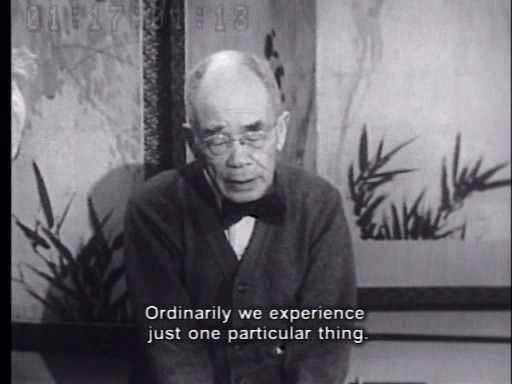
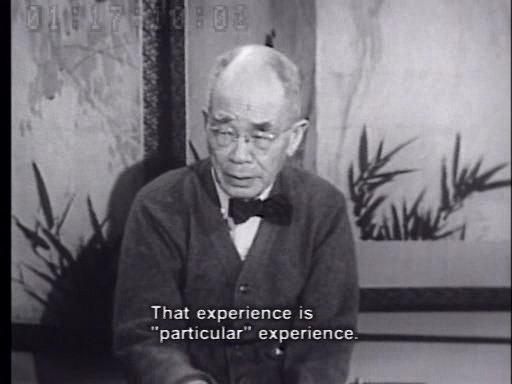




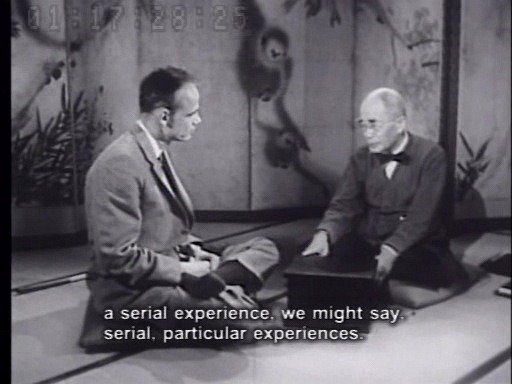
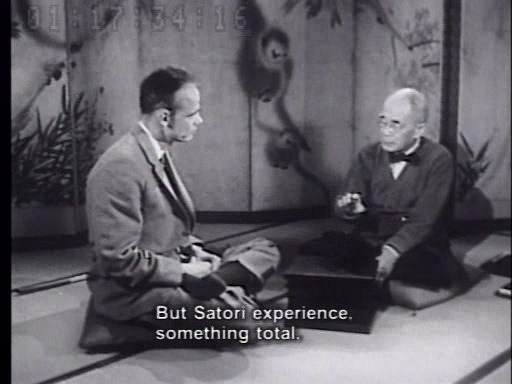
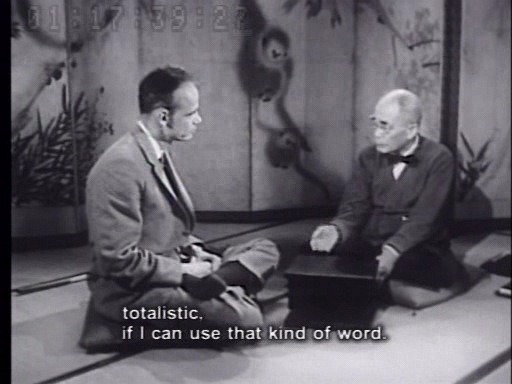
#A Zen Life: D.T. Suzuki#satori#zen#zen buddhism#buddhism#Daisetsu Teitaro Suzuki#D. T. Suzuki#japan#2006#Michael Goldberg
8 notes
·
View notes
Video
youtube
鈴木大拙館 D. T. Suzuki Musum in KANAZAWA. #鈴木大拙館 #japanesegarden #zen
#youtube#daisetsu teitaro suzuki#suzuki museum#kanazawa#buddhism#zen#zen buddhism#chan#chan buddhism#japan#japanese#contemplation#yurara sarara
0 notes
Text
“We have two eyes to see two sides of things, but there must be a third eye which will see everything at the same time and yet not see anything. That is to understand Zen.”
~ Daisetsu Teitaro Suzuki
Artist: A. Andrew Gonzalez

21 notes
·
View notes
Text
How To Become Spiritually Enlightened

Peaceful correspondence is correspondence that is liberated from judgment and antagonism and does exclude fanciful viewpoints.
For Smart Activity, Focus on An Existence Of Truth And Love
Smart Activity should be accomplished through careful decision. You should choose to commit yourself to the way of affection and harmony.
For Right Life, Have a go at Cherishing Thoughtfulness
Right life is tied in with aiding individuals and creatures in your day to day existence, about aiding your local area.
For Right Exertion, center around the positive
Regardless of where you are or who you are with, center around the up-sides. Be the most considerate and most empathetic you that you can be, and attempt to rouse others to be the generosity and most merciful they can be as well.
Incorproate care in all parts of your life.
For Right Focus, practice reflection. Check out non dual awareness acim.
There are great many reflection strategies. Furthermore, joined they offer bunch benefits, of which one is edification.
Buddhists use contemplation to make Kensho and Satori.
"Kensho" signifies "seeing the real essence of things" as indicated by Philip Kapleau [The three mainstays of Zen]. Furthermore "Satori "signifies "awakening getting it" as indicated by Daisetsu Teitaro Suzuki [An Prologue to Harmony Buddhism]
At the point when we use reflection to become illuminated, we are preparing the brain to see and appreciate the real essence of the universe. Visit https://nondualteacher.com/self-realization-with-david-hoffmeister-practical-non-duality/ for More info.
There are heaps of contemplation procedures for illumination.
To become illuminated, you want to utilize explicit reflection procedures. You need to utilize the main strategies, like Samatha, Vipassana, and Dhyana and set up them into a particular example that turns into a way.
0 notes
Photo



El amor todo lo abarca y todo lo perdona; es un disolvente universal, un agente vivaz e infinitamente creador.
Daisetsu Suzuki
#Daisetsu Suzuki#filosofía#amor#agente#creador#vivaz#universal#disolvente#foto#photoset#set de fotos#Daisetsu Teitaro Suzuki#鈴木 大拙
17 notes
·
View notes
Photo

By Shigeru Tamura(1909-1987) - 現代日本の百人(1953年刊), Public Domain, https://commons.wikimedia.org/w/index.php?curid=46803174
#shigeru tamura#Daisetsu Teitaro Suzuki#D. T. Suzuki#photography#photograph#black and white#tamura#1909#1987#09#87#20th century
0 notes
Photo

1 note
·
View note
Text
15. dr. suzuki museum kanazawa
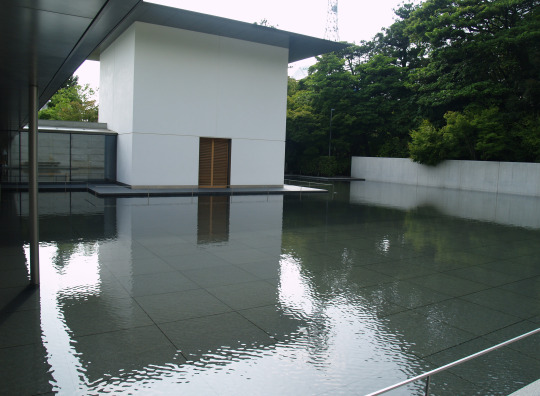
“ zen in it’s essence is the art of seeing into the nature of one’s being, and it point the way from bondage to freedom.”
“we have two eyes to see two sides of things, but there must be a third eye which will see everything at the same time and yet not see anything. that is to understand zen.”
“when zen is thoroughly understood, absolute peace of mind is attained, and a man lives as he ought to live.”
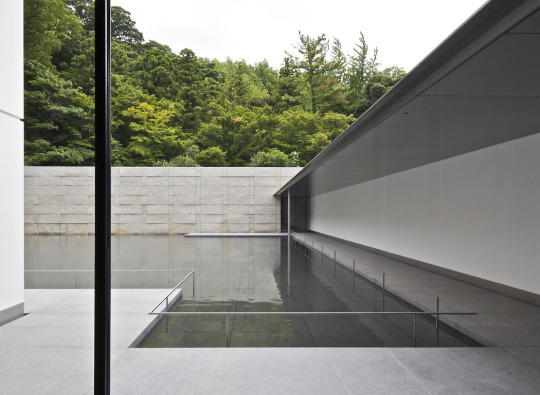
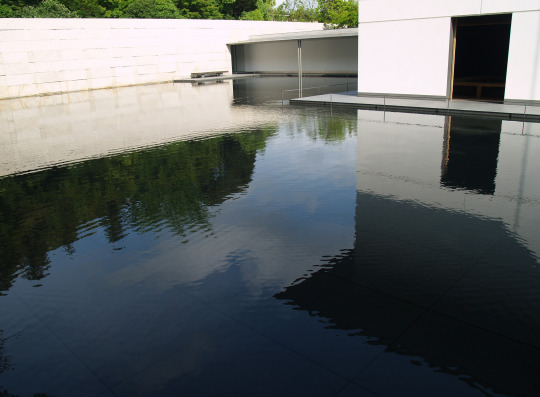
in kanazawa eert een klein museum het leven en werk van de boeddhistische filosoof daisetsu teitaro suzuki 鈴木 大拙 貞太郎 (1870-1966).
d.t. suzuki schreef vooral over de relatie en invloed van boeddhisme, zen en shin op het dagelijks leven. hij stript identiteit tot de meest essentiële en fundamentele staat van zijn.
hij is onderlegd in het sanskrit, vertaalt vele religieuze teksten en introduceert de japanse filosofie bij vele westerse schrijvers, dichters en musici.
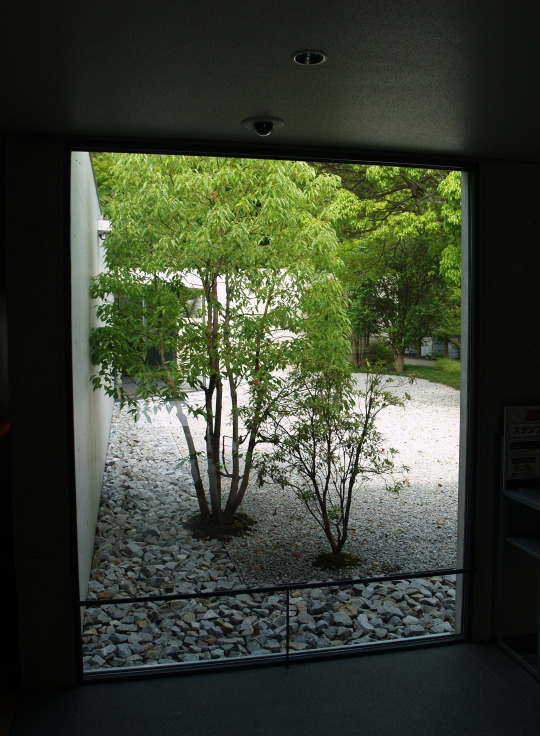
architect yoshio taniguchi tekende hier de sereniteit van zijn filosofie.
enkel verlicht door een vloer-tot-plafond raam loop je langs een portret van d.t. suzuki naar de tentoonstellingsruimte.
de tentoonstelling etaleert de mijlpalen in zijn leven en werk: quotes, teksten, foto’s en interactieve touchscreens. in een leeszone kun je in het engels of japans zijn boeken lezen. stilte is hier het sleutelwoord.
de contemplatieve ruimte ligt in het midden van de waterspiegeltuin omringd door witte muren en groene wildernis. een vierkante ruimte aan de vier zijden open. op de centraal geplaatste zetels. neem je je tijd, je ademt, geniet van de rust, mediteert, dwaalt over het reflecterend water, blikt op de robuuste muur, op de kruinen van de bomen en de blauwe lucht… een spiritueel paviljoen.


de sereniteit doorheen heel het museum blijft me nog steeds bij: de grijstinten, de zuivere en simpele vormgeving, het dunne watervlak, de muur met overdragend groen,… een soort eeuwigdurendheid. dit verfijnd minimalisme creëert een allesomvattend wow-gevoel voor schoonheid.

vooral zonnige morgenden en avonden zijn een uniek spektakel: de reflectie in het ommuurde water en de kalmerende natuur van het gebouw presenteren je een kleine oase om te reflecteren over je leven.
dit is meer een meditatiecentrum dan een museum. het plaatst de zengedachte in de praktijk.
het watervlak met zijn abstracte schoonheid belichaamt suzuki’s filosofie. zen gericht op individuele ervaring en spirituele verlichting.

deze architectuur bekeert je niet tot het boeddhisme, maar spiegelt je de essentie van het leven voor.
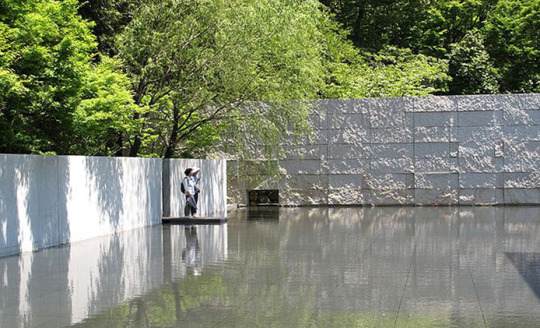
3 notes
·
View notes
Text
Daisetsu Teitaro Suzuki
Daisetsu Teitaro Suzuki (鈴木 大拙 Suzuki Daisetsu?, 18 de octubre de 1870 – 12 de julio de 1966) fue un filósofo japonés, reconocido como uno de los promotores del zen en Occidente. Su nombre de nacimiento fue Teitarō (貞太郎?) y su nombre budista como monje fue Daisetsu, pero internacionalmente fue conocido con sus dos nombres juntos, así como D. T. Suzuki o Daisetz Teitaro Suzuki.
Ha sido uno de…
View On WordPress
0 notes
Quote
alışageldiğimiz düşünceleri altüst eden karşıtlıkların temelinde, normal konuşma diliyle anlatma zorluğu yatar. çünkü içsel yaşantılarımız, konuşma dilinin sınırlarını fazlasıyla aşar.
daisetsu teitaro suzuki
#words#word#book#books#kitap#kitaplar#kitaplık#literatüre#felsefe#edebiyat#okuma notları#okumasaati#okumahalleri#poema#poems#artist#notes#notlar#writer
44 notes
·
View notes
Text
YUGEN
“an awareness of the universe that triggers emotional responses too deep and mysterious for words.”

Yugen is a compound word, each part, yu and gen, meaning “cloudy impenetrability,” and the combination meaning “obscurity,” “unknowability,” “mystery,” “beyond intellectual calculability,” but not “utter darkness.” An object so designated is not subject to dialectical analysis or to a clear-cut definition. It is not at all presentable to our sense-intellect as this or that, but this does not mean that the object is altogether beyond the reach of human experience. In fact, it is experienced by us, and yet we cannot take it out into the broad daylight of objective publicity. It is something we feel within ourselves, and yet it is an object about which we can talk, it is an object of mutual communication only among those who have the feeling of it. It is hidden behind the clouds, but not entirely out of sight, for we feel its presence, its secret message being transmitted through the darkness however impenetrable to the intellect. The feeling is all in all. Cloudiness or obscurity or indefinability is indeed characteristic of the feeling. But it would be a great mistake if we took this cloudiness for something experientially valueless or devoid of significance to our daily life. We must remember that Reality or the source of all things is to the human understanding an unknown quantity, but that we can feel it in a most concrete way.
Words by Daisetsu Teitaro Suzuki, in Zen and Japanese Culture
Gif via @cosmosondrugs
#yugen#spirituality#japanese#culture#oneness#duality#universe#energy#we are one#enlightenment#words of wisdom#quote#quotes#meditation#chakra#chakras#kundalini#wisdom#yoga#yogi#halucination#trippy#galaxy#space#gif#staywoke#team love#love#inner journey
2K notes
·
View notes
Text
Swedenborgianism: A Brief History
From The Swedenborgian Church of North America

The Swedenborgian movement began in Sweden, France, and England in the 1780s, as a movement looking to reform older Christian traditions. The first Swedenborgian church was registered in England in 1787, and the artist William Blake was one of the members of that first church.
Swedenborgian thought spread through the efforts of many people, including John Chapman (1774-1845) who was also known as Johnny Appleseed. Johnny Appleseed is most well known for all of the apple trees that he planted in the Midwest, as well as for spreading “good news, right fresh from heaven.” He would give away pieces of Swedenborg’s theological writings as he traveled.
Swedenborgians became known for believing in: the oneness of God, the afterlife, a deeper meaning to the Bible, and the importance of living a good life. Swedenborg’s writings were very popular at that time in the United States. Notable Swedenborgians include William Blake, Charles Bonney, John Chapman, Ralph Waldo Emerson, Helen Keller, Dr. Kristine Mann, Howard Pyle, Daisetsu Teitaro Suzuki, and Eliza Tibbets.
Except in rare years of national emergencies, an annual summer convention has been held since the first one in 1817. In fact, prior to changing their name, the church was called the “General Convention of the New Jerusalem.” It is at this convention that ideas are shared, business meetings are held, policies are created, and elections of the officers of the church are voted upon. Each church/region sends a delegation of members to vote on denominational business.
The Swedenborgian Church of North America ordained their first female minister in 1975, and their first openly gay minister in 1997. The organization in North America consists of many different churches who follow Swedenborg’s theology. Its spiritually rich and inclusive ministries can be found throughout North America and online.

#religion#christianity#protestantism#swedenborgianism#swedenborgian church of north america#divinum-pacis
1 note
·
View note
Text
Blog #8
“Those who dwell as scientists or laymen, among the beauties and mysteries of the earth, are never alone or weary of life.”—Rachel Carson
I believe that this quote is true. With something new to discover or a new specimen to study, life can always find a way to draw interest. Even in the world of quantum physics, which I was just agonizing over earlier, there are always new things to learn, because we know very little about how and why particles interact with each other. The article I read earlier concerned itself with the prospect that quantum tunneling is instantaneous based on a recent study, which overwrites a previous study from 2017 that claimed that quantum tunneling required approximately 18 attoseconds (a billionth of a billionth of a second). The recent study observed that quantum tunneling only required one attosecond. I then began to ponder the ramifications of an organism that depended on quantum tunneling in order to receive nutrients, and decided while it is highly unlikely and would be pointless, there is the tiniest possibility. I am unsure of whether or not this is true because I still need to look more into the correspondence between quantum physics, biology, and chemistry, but it certainly did not wear me out.

A basic diagram of the concept of quantum tunneling. Taken from https://newatlas.com/time-electron-quantum-tunneling/50784/
“Each moment is absolute, alive, and significant. The frog leaps, the cricket sings, a dewdrop glitters on the lotus lead, a breeze passes through the pine branches, and the moonlight falls on the murmuring stream.”–Daisetsu Teitaro Suzuki
This is a beautiful quote that displays the importance and the broad existence of time. As we experience it, time is a strict progression from past to present to future. Right now, on a more-than-a-few-qubit-scale, we cannot reverse time (time was recently reversed in a quantum computer for a couple of qubits). As such, it is probably best for now to live in the moment and experience change and growth through the linear progression of time. Every moment we experience does not exist for us alone: the universe moves on with us (or without us). The eternal continuation of time (moving at non-light speed) is calm and slow. Or extremely fast, depending on the amount of focus paid to the time. Everything this is alive now simply is, and will continue to be for an amount of time. Experience it before it stops being alive.

An image that depicts how time feels sometimes: endless. The link is where this picture originates from as well as an article about the 2017 study. Taken from https://www.sciencealert.com/physicists-successfully-put-time-into-reverse-on-the-smallest-scale
“Study nature, stay close to nature. It will never fail you.”–Frank Lloyd Wright
Nature takes its path as simply and as cleanly as possible. Nature is not at fault for its survival, it acts much like as any living creature would: preservation first. Climate change exists, there is in fact, no denying such a phenomenon is occurring. The argument whether this is a natural process or caused by our use of fossil fuel, production of methane, and pollution is also existing. While global climate changes have occurred naturally before, it is certainly moving faster than in previous ages. Whatever the final result of the whole issue with global warming or whatever other catastrophic calamity strikes the Earth, short of the sun enveloping the planet, nature will always find a way to persevere and start again.

It is my belief that one day, if nothing changes, this will be the future of the planet. Taken from https://guerrillaworldpress.wordpress.com/tag/politics/
Janaro, R. P., & Altshuler, T. C. (2012). The art of being human: The humanities as a technique for living (10th ed.). New York City, NY: Pearson.
0 notes
Link
Kanazawa, the capital city of Ishikawa Prefecture, sits on the Sea of Japan, bordered by scenic mountain ranges and national parks, has well-preserved art and culture.
As it is one of the few major cities in the country that was spared from the fire bombing in World War II, it is the best-preserved Edo Period city in Japan. Known to the locals as little Kyoto because of its beautifully preserved traditional neighborhoods, but without the throngs of tourists, this is one charming city you wouldn’t want to miss! As a guide, read on for the 10 things you can do in Kanazawa!
1. Ninja Temple
Myoryuji Temple (妙立寺, Myōryūji), commonly known as Ninja Temple (Ninjadera in Japanese), was built in 1585 by Lord Maeda Toshiie as a place of worship during the Edo Period. It gained its nickname because of its many deceptive defences to guard against intruders or attack. The temple looks like a 2-story building on the outside, but it is actually a four-story building with a complicated structure designed to fool enemies and intruders. Explore the Ninja Temple to see for yourself the fascinating designs of this ancient architecture!
2. Kanazawa gold leaf soft serve
Recognised as a City of Crafts and Folk Art in the UNESCO Creative Cities Network, Kanazawa is Japan’s capital of gold leaf. It seems only logical that Hakuichi, the city’s main gold leaf producer, also started selling soft serve cones wrapped in real gold leaf. Pretty images of this eye-catching sweet treat are now all over social media in Japan, a novel experience that is fast catching up for both locals and tourists alike. So don’t forget to grab a trendy gold-topped ice cream cone when you are in Kanazawa!
3. Walking in the Kanazawa Higashi Chaya District
There are three well-preserved chaya districts in Kanazawa, with the largest and most interesting being the Higashi Chaya District. Chaya, which means teahouse in Japanese, played an important role in designated entertainment districts during the Edo Period. Guests to the exclusive restaurant would be entertained by geisha (professional entertainer) with traditional song and dance. In this cultural district, take your time to shop and enjoy a unique cafe-hopping experience along the central street. Discover the intriguing teahouse heritage at the Shima Teahouse which has been converted into a museum.
4. 21st Century Museum of Contemporary Art
The 21st Century Museum of Contemporary Art (金沢21世紀美術館) is one of the most popular art museums in Japan exhibiting works of notable contemporary artists in the country and all over the world. The deliberate design of the circular museum architecture without any main entrance makes it unique, standing out from other museums and buildings around Kanazawa. Immerse yourself in this modern art space and be amazed by the creative exhibits in the museum!
5. Kanazawa handicraft experience
Join a half-day tour in the creative city of Kanazawa, to experience the making of gold lacquer decoration, one of the city’s greatest arts! You will also be able to enjoy tantalising local sweets and green tea at the famous Nosaku and marvel at the beauty of the historical Kenrokuen (兼六園) garden established during the Edo Period. Finally, bring a miniature Samurai armour model home, a great souvenir from Japan!
6. Nagamachi Bukeyashiki, the samurai district
The Japanese samurai refer to the middle and upper class warriors during the Edo Period. Travel back into pre-modern Japan as you roam the historic samurai district in Nagamachi Bukeyashiki. Notable attractions in the district include the Nomura-ke - a restored samurai residence displaying the lifestyle and artifacts of the era, and the Shinise Kinenkan Museum - a restored pharmacy that prospered following the decline of the samurai.
7. 1-day trip from Kanazawa to the neighbouring Gifu Prefecture
Less than 2 hours away from Kanazawa lies the mountainous Gifu Prefecture with spellbinding landscapes. You can book a one-day trip to the scenic Gokayama, Shirakawago or Takayama where you can visit UNESCO World Heritage Sites (Shirakawago village and Ainokura village) and best-preserved traditional old towns in Takayama. Have fun making your own senbei rice crackers in the traditional shopping street - Sasaraya at Gokayama!
8. Kenrokuen Garden
The ancient Kenrokuen Garden (兼六園) built during the Edo Period is one of the Great Three Gardens of Japan, and the top attraction for Kanazawa visitors. These attributes make for a perfect garden. The wide variety of flowering trees gives the spacious private garden a different look every season. Come visit the garden in different seasons and experience the difference for yourself!
9. Dine in one of the small restaurants in Katamachi area
The strategic location of Kanazawa between the Sea of Japan and the Japanese Alps makes it a great place to tuck into amazingly fresh sashimi and sushi. At the Katamachi area, there are many reasonably-priced small restaurants where you can tuck into fresh sushi and sashimi made right in front of you. Experience a homely dining experience without burning a hole in your wallet!
10. D.T. Suzuki Museum
Opened in 2011, D.T. Suzuki Museum (鈴木大拙館, Suzuki Daisetsu Kan) is a small museum honouring the life and works of a prominent local Buddhist philosopher - Suzuki Daisetz Teitaro. Just like the Japanese Zen philosophy that Mr. Suzuki believes in, the museum’s use of clean, simple designs and open spaces allows visitors to pause, immerse in the serenity of the surroundings and reflect. Visit the museum to unwind from the hustles of the city!
Read also: Top 9 things to do in Himeji, Japan
From : https://wikitopx.com/orther/top-10-things-to-do-in-kanazawa-japan-705685.html
0 notes
Text
La vacuidad, conceptualmente susceptible de ser confundida con la pura nada, es de hecho la reserva de infinitas posibilidades.
Daisetsu Suzuki
#Daisetsu Suzuki#filosofía#vacuidad#nada#susceptible#Teitaro Suzuki#Suzuki Daisetsu Teitarō#鈴木 大拙 貞太郎
4 notes
·
View notes
Photo



1942—Daisetsu Teitaro Suzuki’s lectures at Columbia University introduced Cage to the principles of Zen
Soon after, Cage began working with the I Ching - Book of Changes
0 notes